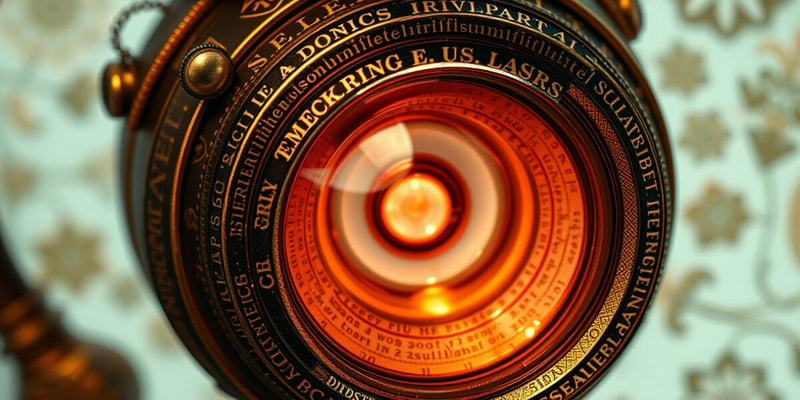Podcast
Questions and Answers
What is the primary assertion of germ theory in medicine?
What is the primary assertion of germ theory in medicine?
What was Edward Jenner's significant contribution to the field of microbiology?
What was Edward Jenner's significant contribution to the field of microbiology?
Which of the following statements about Koch's postulates is TRUE?
Which of the following statements about Koch's postulates is TRUE?
What was the main finding of the Hershey-Chase experiments?
What was the main finding of the Hershey-Chase experiments?
Signup and view all the answers
In what year did Robert Koch publish his postulates?
In what year did Robert Koch publish his postulates?
Signup and view all the answers
Which microorganism was NOT linked to Koch's different experiments?
Which microorganism was NOT linked to Koch's different experiments?
Signup and view all the answers
What process do viruses require for replication according to the content?
What process do viruses require for replication according to the content?
Signup and view all the answers
What did the Urey-Miller experiment demonstrate?
What did the Urey-Miller experiment demonstrate?
Signup and view all the answers
Which statement about the connection between HIV and AIDS is posed as a question in the content?
Which statement about the connection between HIV and AIDS is posed as a question in the content?
Signup and view all the answers
What was Anton von Leeuwenhoek's significant contribution to microbiology?
What was Anton von Leeuwenhoek's significant contribution to microbiology?
Signup and view all the answers
What conclusion did Francesco Redi reach from his experiments regarding maggots?
What conclusion did Francesco Redi reach from his experiments regarding maggots?
Signup and view all the answers
How did John Needham contribute to the debate on spontaneous generation?
How did John Needham contribute to the debate on spontaneous generation?
Signup and view all the answers
What was Lazzaro Spallanzani's main argument against Needham's findings?
What was Lazzaro Spallanzani's main argument against Needham's findings?
Signup and view all the answers
Louis Pasteur's experiments led to which significant conclusion?
Louis Pasteur's experiments led to which significant conclusion?
Signup and view all the answers
What important theory did Louis Pasteur publish as a result of his work?
What important theory did Louis Pasteur publish as a result of his work?
Signup and view all the answers
What experiment did Louis Pasteur utilize to prove his hypothesis about microbes?
What experiment did Louis Pasteur utilize to prove his hypothesis about microbes?
Signup and view all the answers
How did Spallanzani build upon the work of Redi in his experiments?
How did Spallanzani build upon the work of Redi in his experiments?
Signup and view all the answers
What misconception did John Needham's results suggest about the origins of microbial life?
What misconception did John Needham's results suggest about the origins of microbial life?
Signup and view all the answers
Why was the work of Louis Pasteur particularly notable in the context of the debate on spontaneous generation?
Why was the work of Louis Pasteur particularly notable in the context of the debate on spontaneous generation?
Signup and view all the answers
Study Notes
Microscope Innovations and Early Discoveries
- Anton von Leeuwenhoek developed a primitive microscope with a 20x lens, first observing enlarged invertebrates and coining the term "Animalcules."
- Initially believed in spontaneous generation, observing maggots arising from rotting meat, suggesting life could emerge from the dead.
Challenging Spontaneous Generation
- Francesco Redi conducted experiments in 1668 that disproved spontaneous generation, showing that flies, not dead meat, caused maggots to appear.
- Used open, sealed, and gauze-covered flasks to demonstrate the need for flies to access the meat for maggot formation.
Disputes in the Act of Spontaneous Generation
- John Needham, in 1745, countered Redi's findings, asserting that boiling meat broth could yield microbes without flies, proposing a "vital force" in dead matter.
- Lazzaro Spallanzani refuted Needham's claims in 1760 by boiling sealed flasks of broth, finding no microbial growth, thus supporting that dust and flies introduce life into an environment.
Pasteur's Groundbreaking Discoveries
- Louis Pasteur, in 1857, refuted Spallanzani by showing that dust is the source of microbial growth.
- Utilized flasks with a dust trap to sterilize broth without contamination, leading to his germ theory, which proposed that microorganisms cause disease and spoilage.
- Developed the process of pasteurization to prevent spoilage in food and linked specific germs to diseases, notably vibrio cholera with puerperal fever.
Vaccination Milestones
- Edward Jenner pioneered vaccination in 1796 by using cowpox to immunize against smallpox, demonstrating the principle of vaccination (Vaccinia) through his experimentation on a young boy.
Koch's Contributions to Microbiology
- Robert Koch, in the late 19th century, established a direct link between specific microbes and diseases, most notably anthrax, cholera, and rabies.
- Developed Koch's Postulates, a set of criteria to attribute diseases to specific pathogens.
Modern Understandings and Challenges
- Considerations of diseases like syphilis and leprosy highlight gaps in Koch's Postulates concerning pathogens that do not fit the traditional model, such as viruses and prions that require living hosts for propagation.
Discoveries in Genetic Material
- Hershey and Chase's experiments in 1953 confirmed DNA as the genetic material responsible for heredity and pathogenic transformation, overshadowing prior theories focusing on proteins.
- The Urey-Miller experiment simulated primitive Earth conditions to produce amino acids, further analyzing spontaneous generation and the origins of life.
Noteworthy Microbial Survival
- Helicobacter Pylori can survive in the nonacidic mucin layer of the stomach, exhibiting unique adaptations to extreme environments.
- The ongoing discussion concerning HIV causing AIDS raises ethical questions about research models, particularly in the absence of animal studies.
Studying That Suits You
Use AI to generate personalized quizzes and flashcards to suit your learning preferences.
Related Documents
Description
Explore the groundbreaking work of early scientists like Anton von Leeuwenhoek and Francesco Redi who challenged the idea of spontaneous generation. This quiz covers significant discoveries and experiments that shaped our understanding of life and microbiology in the 17th and 18th centuries.




